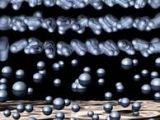How would it be if electric current would pass through wires without any resistance and if liquids would loose their viscosity and would start climbing on the vessels' walls? That's exactly what happens at very low temperatures, close to absolute zero!
To understand the phenomenon of superfluidity and the phenomenon of superconductivity, which in fact are one and the same phenomenon, you have to know two things.
On one hand you need to know that the entire world is made up of two kinds of particles. The particles of the first kind, called fermions, are the ones that cannot stand one over the other. For example it's impossible to compel two electrons (which are fermions) to stay in the exact same place. The particles of the second kind, called bosons, on the contrary, love staying one on top of the other, they have the tendency of overlapping rather than repelling. That's what happens for instance to photons (the particles of light).
On the other hand you need to be aware of the maybe most bizarre aspect of quantum mechanics: the fact that our world is only apparently tridimensional, in reality it is formed from two tridimensional worlds that we see superimposed onto each other: everywhere we think we see one point in fact there are two points. An elementary particle (such as an electron) when it rotates around its axis is passes from one part of the world into the other part, as if it would climb on a spiral; when it rotates furthermore it goes back as if the spiral would descend back into the first part of world.
When you turn around, once you have rotated 360 degrees you are looking again into the same direction as you initially were. However, if you were an electron, after revolving 360 degrees around your own axis you would look into the opposite direction as you initially were (you have climbed on the spiral); in order to look again into the initial direction you need to rotate another 360 degrees. Bizarre!
The main idea right now is that two fermions can stay apparently in the same place if one stays in the upper position on the spiral, and the other one stays in the lower position on the spiral. The electron's property that describes where is the electron on the spiral is called "spin" (because the fermion reaches the upper of lower position by spinning around its axis). A boson, unlike a fermion, occupies both places on the spiral, they don't stay up or down, they are "large" enough to stay in both positions simultaneously.
The point is this: two fermions, one in the upper position (having the spin "up"), and the other in the lower position (having the spin "down") are like a single particle - and this particle is a boson! In other words, two particles that absolutely hate encountering other particles group together in pairs, and these pairs love meeting and overlapping other pairs! That's how bizarre is the world of quantum particles.
The electric resistance or viscosity are caused by fermions' properties, by the fact that they refuse to pass one through the other - that's why the electrons are colliding with the metal's crystal net (this is the cause of the electrical resistance), and the liquid particles are colliding with each other (this is why internal friction exists in liquids, i.e. viscosity).
Superconductivity appears when electrons stay in pairs and thus pass one through the other, and superfluidity (that was observed for instance in liquid helium) appears when electrically neutre particles combine into one "big" boson and thus pass through each other. That's how electrical resistance and viscosity can disappear completely.
The problem now is to obtain such pairs of fermions - i.e. to "convince" the electrons to keep their places inside the pair, instead of randomly jumping in all directions as they usually do. All this "jumpiness" is called heat - something is hotter when its particles jump around more. (This is why for example when we heat a liquid it begins to boil: the particles begin to jump around in such a crazed way that they get out of the liquid.) Thus, the fermions stand still only when the temperature is low. The absolute zero is the temperature where all motion stops. It isn't necessary to reach absolute zero in order to obtain superconductivity or superfluidity, but nonetheless one needs to cool things to very low temperatures.
Of course, it isn't the first time when superfluids are observed. The novel thing now observed, something that physicists speculated for decades, was a superfluid having a large number of free fermions - around 10 percent.
Until recently, researchers couldn't observe what would happen in such a mix simply because the cooling techniques weren't sufficiently developed - the researchers couldn't set the experimental conditions very accurately. But a lot of things changed during the last ten years. This allowed Randy Hulet's team from Rice University to conduct a much more precise experiment. The have reached at 30 billionth of a degree from absolute zero (!!!) cooling a mix of lithium-6 (these are fermions). They have thus obtained a superfluid. Than, they have passed ultrasounds (these are very fast vibrations) through the superfluid. This way some of the fermions were freed. Raising the level of vibrations, more and more fermions were freed. What Hulet's team has found is that the superfluid retains its qualities up until around 10 percent of the fermions have been freed. They have thus confirmed the speculations claiming that it isn't necessary for all the fermions to be coupled together in order to have a superfluid.

 14 DAY TRIAL //
14 DAY TRIAL // 
